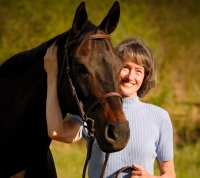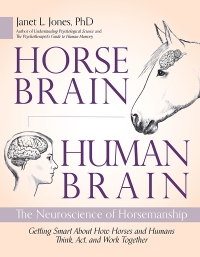TRUE TRAINING 73 - The Foundations of All Training
Too often, we forget to consider the basic building blocks of a horse’s training. I’m not referring to signals for “whoa” and “go” or to direct reining left and right. I’m referring to basic health and welfare issues that allow a horse to have a sound mind and body that are receptive to learning. I watch these factors very carefully for True, and I hope you do the same for your horses!
Water – If you were raised like I was, leaving a captive animal without water for even an hour is a crime. The average horse exercised moderately needs 20-30 gallons of water a day in a cool humid climate. She needs more in hot weather or with heavy exercise. Buckets are the least reliable method. Instead, use automatic waterers or 100-gallon stock tanks with submersible heaters in winter. Check both daily. Place a salt block next to each horse’s water.
Food – A horse should eat 2% of his body weight in hay every day. So, if your horse’s best weight is 1000 pounds, he needs to eat 20 pounds of hay per day to maintain that. If he weighs 1500 pounds, he needs 30 pounds a day. Your veterinarian can estimate your horse’s weight, then you can weigh a flake of your hay to determine how many flakes to feed. Hay cannot be fed accurately by volume because some bales are packed more tightly than others. Use a spring scale (available for $15-$20) to weigh flakes every time you change hay. Supplements may be added to this hay if needed—but if you’re feeding high-quality hay or fresh grass, they usually aren’t.
Cleanliness – If your horse is standing in manure or urine, get ready for a good deep case of thrush that will make her unsound. Stalls, runs, and waterers should be cleaned daily. Manure needs to be picked up from turnouts weekly. Alternatively, if your weather conditions permit, it can be dragged or spread (weekly or monthly, depending on pasture size) to dry in the sun.
Air – This would seem to be a no-brainer, but lots of people close off ventilation in the barn to keep it warm. Equine body temperatures are higher than humans’, and unclipped horses wear heavy fur coats. When it’s zero outside, they are toasty warm. It’s much more important to open all the barn doors and allow as much fresh air as possible to circulate. This reduces the dangers of ammonia fumes from urine and dust from bedding or indoor arenas. Equine lungs are much more sensitive and delicate than human lungs—so ammonia and dust are major risks.
Socialization – Horses are herd animals. They need buddies! A horse kept alone needs a companion in the form of a donkey, burro, mule, mini, or another horse. Ideally, a horse will live with a group of equine companions in a barn or pasture.
Turnout – Fish are made to swim, birds are made to fly. Horses are made to MOVE. Movement is critical for equine health: it prevents colic, reduces stiffness, improves mental health, enhances blood circulation for healing, and maintains soundness. Most experts agree that limiting equine movement is a breach of ethics, as stated in the Brambell Report which contains the guidelines for animal welfare laws in Western countries.
Rest – I’ve written elsewhere about the dangers of imposing human workloads on horses, especially when it comes to mental attention and learned behavior. Adult horses need to be handled by humans for 2 or maybe 3 hours a day. After that, go away!
Risk Assessment – Assessing potential dangers in your horse’s environment is the daily responsibility of every horse owner, rider, and trainer. It’s up to you to be certain that the horses in your care have their basic needs met. Monitor the horse’s exercise to avoid repetitive use injuries or overwork. Look for safety hazards in stalls, barn aisles, arenas, turnouts, and grooming areas. When you find one, get it fixed as soon as possible.
Deworming – Horses need to be checked and/or dewormed three to four times a year, depending on local conditions. Your veterinarian can describe the routine you should use for your climate and location. Horses with worms suffer weight loss, dull coats, digestive problems, mental fatigue, and inability to work. They can die.
Soundness – One of my pet peeves is to see a horse ridden or worked who is not sound. Sometimes this happens because people don’t notice the lameness, other times because they figure “it will go away,” “it’s only stiffness,” or “we can’t scratch” after driving all the way to a competition. None of that is relevant. If a horse shows any pain—ANY--, put her away to rest immediately. Provide basic first aid, ice or cold-hose hot spots, and if needed call your veterinarian for help.
Age – Often for financial reasons, people push young horses before their bodies are ready for advanced work. Horses don’t mature till 5 to 7 years of age. That means your three-year-old has no business jumping, barrel racing, reining, cutting, roping, or doing dressage that weights the hindquarters. Instead, focus on the basics for immature animals. When they’re five, you can start teaching them these advanced activities. You’ll be much more likely to end up with a horse who stays sound into old age and has the mental capacity to learn new maneuvers quickly, without being overfaced or broken in spirit.
There ya have it -– Janet’s Top Ten. OK, there are eleven, but all are important. Thanks for reading!

